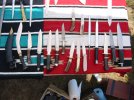unwisefool
Gold Member
- Joined
- Jan 22, 2007
- Messages
- 10,036
Well not for that one, it lost it's handle!
The BladeForums.com 2024 Traditional Knife is ready to order! See this thread for details:
https://www.bladeforums.com/threads/bladeforums-2024-traditional-knife.2003187/
Price is $300 $250 ea (shipped within CONUS). If you live outside the US, I will contact you after your order for extra shipping charges.
Order here: https://www.bladeforums.com/help/2024-traditional/ - Order as many as you like, we have plenty.
Well not for that one, it lost it's handle!
Yeah, likely got brittle and broken when they moved these relics from Nepal. The building these items were in was in disrepair. The items didn't get much protection from outdoor weather and natures elements. But, it's still cool to have items that came from that great purchase of that building's contents done about 20+ years ago by the owners of Windlass Steelcrafts and International Military Arms... It was a joint venture by those two firms.Well not for that one, it lost it's handle!
The whole point of such construction in many cultures is that the blade is what matters, and the handle is expected to wear out long before the blade does. Doing it this way makes it much easer to replace. Its just a matter or driving the handle off and putting a new one on. Handles are cheap, good blades not so much.....Well not for that one, it lost it's handle!
Yeah man, it's a jokeThe whole point of such construction in many cultures is that the blade is what matters, and the handle is expected to wear out long before the blade does. Doing it this way makes it much easer to replace. Its just a matter or driving the handle off and putting a new one on. Handles are cheap, good blades not so much.....
No, I have seen pics of the tangs they did on these knives before... The tang is what you seeCould there be something missing from the bottom of that tang perhaps a wider shaped portion after all of these years maybe still embedded in the old handle. It seems odd to just have a relatively stubby elongated triangle shape. That looks like something that would be very hard to secure.
Those Japanese swords were/are fantastic and well made, outstanding, they took forever to make. I am sure they could cut people wearing armor all day.
The Japanese Samurai were a lot like modern soldiers in that they preferred to shoot their enemies. They were well trained in the use of the bow and arrow which was their primary weapon of choice in battle. I am sure the value of a good AR rifle would not have been overlooked by them. I also understand arrows do not pierce all armor. Hmmmm this is where I am lost maybe this is where the swords would come into play ?? The sword was a valued item I am sure and took a good amount of time and skill to make.
Did they use other weapons too ? Oh sorry I am off topic here.
View attachment 1861545
100% Confident in these. The epoxy is probably tougher than the Sambar Stag is
Speaking of Sambar (I love the stuff, here are some cuties) , I wonder who it was that put this micarta gripped dagger and utility knife together. Other times, pins seem quite useful.View attachment 1861545
100% Confident in these. The epoxy is probably tougher than the Sambar Stag is

